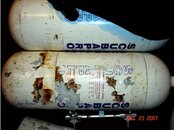I could give a suggestion since I do this for a living.
I own a marine business and steel refinishing is part of what I do.
Here's what you want to do:
1) Remove as much surface rust and scale as posible using a wire brush by hand or by roto tool of some sort, drill, grinder w/ wire brush attachment etc.
2) Treat rust with phosphoric acid such as naval jelly or rust mort. Follow directions. This will kill all the rust right down to clean steel and will not affect any good steel. rinse off all rust killer and dry immediately with towels then compressed air.
3) Spray on a zinc rich primer. The absolute best is an industrial product from Benjamin Moore called CM18 77 zinc rich epoxy primer. It is a catalyzed 2 part system that needs to be sprayed on with an automotive or industrial spraygun. If this is not feasable the next best thing is to use a couple coats of rustoleum zinc rich primer. The reason for zinc is so that in case you do get a nick in the top coat, rust will not spread beyond the exposed area. Zinc acts as a sacrificial metal and will corrode instead of the steel that it sits on.
4) After the zinc has thoroughly dried you can apply the top coat. The best is an epoxy mastic which is for water immersion service. They use this stuff on oil rigs. Epoxy is the only thing that when applied properly will completely block water migration to the steel. This is why we use an epoxy barrier coat on the bottoms of boats prior to application of bottom antifouling paint, to prevent water migration and gelcoat blistering on fiberglass. It works the same way on steel.
Epoxy is also a 2 part product, 1/2 polymer 1/2 catalist, this is a true epoxy and it's tougher than nails, way tougher than any single component air drying product. The products I've used are Interlux and DuPont. DuPont makes a product called 25 P and it comes in a variety of limited muted colors. This stuff is mostly used in marine applications and on machinery that is exposed to highly corrosive, damp or immersed conditions. It can be found at or ordered from most DuPont paint jobbers.
If this is not feasable then I recommend using a top grade catalyzed polyurethane like Imron or Awlgrip. in fact for a glossy custom finish either one of the two last products can be used over an epoxy mastic and the mastic then would serve as a barrier coat plus a primer surfacer. I should add that epoxies don't have any UV protection so they tend to chalk out very quickly in the sun. This only affects the very surface however and the underlying layers will maintain their integrity.
I would avoid using anything out of a spray can for your top coat as this will fail in short order and cause you much more work in the end or a failed tank.
Last, you'll need to make sure all processes are done cold and if you had to dig out any deep rust pits or did any bead blasting the tank will need to be re-hyroed before you put it back in service.
Hope this helps.
Eric Sedletzky
Pacific Coast Marine
Santa Rosa, Ca.




